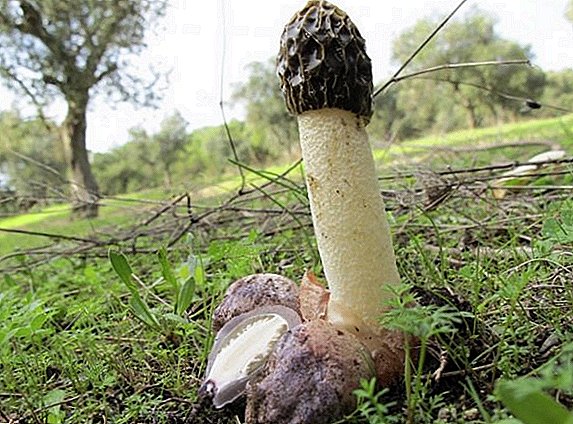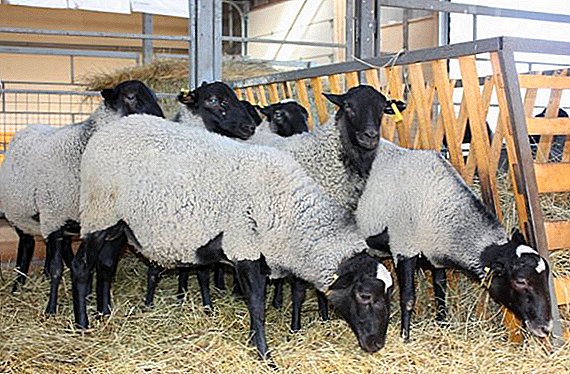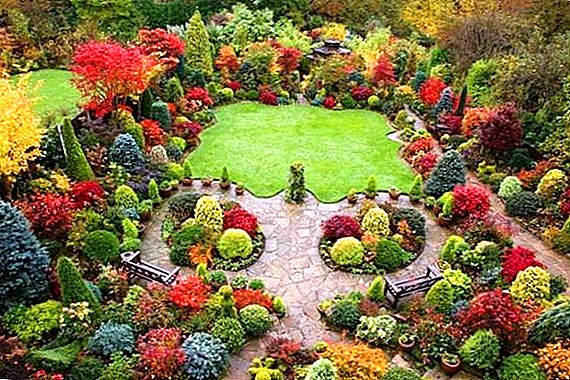
Currently, begonia is considered the most common indoor plant. This subtropical flower attracts flower growers with non-standard leaves and a riot of colors. To love them, just look once. If there is no such plant in your collection yet, this should be corrected.
Begonia is a genus of plants of the Begonese family, numbering 1600 species. Each variety is endowed with unique shapes, sizes, flowering colors and preferences. In the family there are perennials and annuals, represented by herbaceous plants, low shrubs and full semi-shrubs.
Homeland is Africa. It was from there that distribution began to America, Asia, and later around the world. Culture enjoys sufficient fame among our gardeners due to its decorative effect.
Appearance history
For the first time the beauty was found by a priest Charles Plume in the 17th century. He was a member of the expedition to the Antilles. In total, the monk found about 6 representatives of an amazing plant, calling in honor of the friend and the governor of the island, Michel Begon, who organized this study.
Since the discovery of the first types of begonia, it has undergone continuous hybridization and selection. Today, there is a huge number of varieties and hybrid forms, most of which are bred in Belgium. In specialty stores you can often find Begonia Terry Mix.
Features of appearance
Growing shrub (about the varieties of bush begonia can be found here). Well developed root system. Tuberous begonia can grow in open field.
The lush foliage is uniformly green, the leaf itself has an asymmetrical shape with jagged edges. The flower is large, similar to a small rose. Blooming begonia mix has terry buds of red, yellow, pink, white flowers or with a border of various shades along the edges of the petals. An overview of all varieties with bright red leaves can be found in this article, and here we talked about plant species with yellow flowers.
Flowering occurs in the summer with autumn, the room begonia is able to bloom until the beginning of winter.
A photo
Next on the photo you can see what the flower looks like.




Where and how to plant?
Start planting best in March, then the most beautiful blooms will fall on a warm summer period. It is better to give preference to clay and ceramic pots, they allow the roots to be saturated with oxygen.
There are several ways to plant Begonia Mix:
- If you are going to plant begonia with rhizome, do not harvest bulk capacity. Ideally, it should be 4 cm more than the diameter of the roots. Choosing an extremely large pot, the flower will suffer from an overabundance of moisture.
Planting in the pot is done, as well as transplanting, in the spring. Part of the tank is filled with drainage. This is followed by charcoal, which helps to circumvent the process of decay. After it is necessary to mix the fortified soil with humus, sand and peat.
It must be remembered, the young plant does not tolerate the increased acidity of the soil, it should be within 5.5 pH. Planting plant takes positive. Over the years, Begonia grows thicker, growing more leaves. Florists are often grafted or rejuvenated by dividing rhizomes.
- For the tubers planting method, germination is first necessary. This is done by planting in a vitamin-rich environment, containing a flower in the light at high humidity and a temperature of 18 ° C. Watering is better to arrange in the pan, eliminating the ingress of water in the groove on the tuber. After germination, they are planted in a peat pot.
Waiting for the appearance of buds, you can safely divide the tubers into several shares. Split the dried parts, sprinkle with charcoal and plant in pots. To arrange a tuber planting at the end of March, this time is the best for the development of a strong and resistant plant.
Lighting and location
 Begonia - light-loving flower. She is a lover of bright lighting, but at the same time does not tolerate direct sunlight. It is preferable to put the pot on the window from the south-west or south-east side, avoiding the northern windows.
Begonia - light-loving flower. She is a lover of bright lighting, but at the same time does not tolerate direct sunlight. It is preferable to put the pot on the window from the south-west or south-east side, avoiding the northern windows.
Pulling the plant tells about the small sufficiency of daylight. With the cessation of growth and the manifestation of spots on the leaves - it is necessary to rearrange the pot further from the window.
Proper lighting actually deliver using fluorescent lamps and lamps. It is enough to turn on the illuminators for 12-14 hours a day. The light source must be above the location of the flower.
Purchase time terry mix and transportation greatly affect the adaptation to the new place of residence. It is recommended not to start begonia in cold and frosty weather, it risks not to survive sudden temperature drops between the street and the house.
Suitable soil
For apartment cultivation it is necessary to use groundless mixture. The composition simplifies the entry of nutrients from the substrate to the roots. Most groundless mixtures are peat with added perlite or vermiculite. The use of peat often causes some discomfort. Before use, dilute the component with boiling water, softening the material. Apply after cooling.
It is contraindicated to use some standard formulations, for example, humus or leaf earth. Harvesting badly misses the water, which leads to a culture of disease.
The exemplary composition of the soil for the cultivation of begonia: sand, peat and black soil in equal proportions, are also two parts of leafy ground.
Home care
- Watering. Watering begonias recommend enhanced or medium - depending on the time of year. On summer days, the flower needs more moisture; in the cold months, the amount of watering is limited to less. Excess and lack of moisture leads to negative consequences.
The following procedure is recommended to start when the soil dries by 2 cm.
Water should not stagnate, it is necessary to use purified or thawed water, approximately equal to the air temperature in the room.
Your plant will let you know when the comfortable conditions will be realized, and when the watering mode should be changed. Careful attention should be paid to the quality of the water used to moisten the terry begonia. Tap water is not worth taking, because it is sufficiently saturated with chlorine.
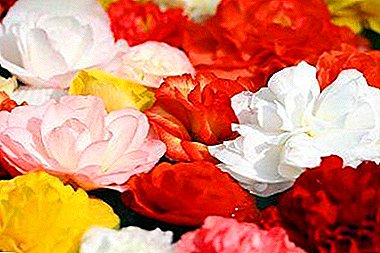 Top dressing. Top dressing is applied twice a month, starting from the period of bud formation and during the entire flowering period. It affects decorative-flowering representatives. For foliage species, nitrogen-free mixtures are required, because this micronutrient accelerates foliage development, slowing the flowering process.
Top dressing. Top dressing is applied twice a month, starting from the period of bud formation and during the entire flowering period. It affects decorative-flowering representatives. For foliage species, nitrogen-free mixtures are required, because this micronutrient accelerates foliage development, slowing the flowering process.If you do not add fertilizing, the leaves will become faded, the plant will become extinct. Buds will be small, the flowering period is short.
- Crop. Eliminating pruning, the plants quickly lose their attractiveness: elongate, the stem exposed, flowers and leaves will become too small. For a luxurious flower, you need to shape the begonias as soon as possible. The procedure is executed in spring according to the above plan:
- When the flower reaches a height of 7-8 cm, pinch the tip, which will stimulate the growth of the lateral processes.
- Reaching 10 cm, the lateral processes of the branches to the top. After the development of new branches the formation of a bush is interrupted.
- The following care comes down to cutting or removing overgrown, unnecessary shoots.
- Rest The plant of the tuberous species after flowering gently turns into a dormant period. To do this, reduce the amount of watering to the complete drying of the aerial part of the indoor flower. All dried parts of the plant are removed by placing the flower itself in a cool room with a temperature of 10-12C of heat for 2.5-3 months.
- Change place. In warm weather, you can make a balcony or loggia. The main thing is not to overdo it, because of the frequent change of location, begonia can bloom with ordinary flowers instead of terry.
Diseases and parasites
- Spider Mite The spider mite does great harm. A small insect is extremely difficult to notice. The consequences of infection lead to the death of begonias. Symptoms - the appearance of dark spots, coating on the branches and foliage in the form of a peel, wilt.
Immediately isolate the tick-marked plant from other crops. In the treatment, use 10% soapy water, then rinse with warm water. For effective struggle to apply insecticide, increasing the humidity of the air.
- Tuberous Rot. The spread of rot begins regularly in a dormant period. About 50% of planting material runs the risk of loss. Frequent inspection and removal of all darkened areas of the tuber will help resist rotting.
- Nematodes. Affect the tubers and leaves. Attacked tuber must be destroyed. Suspecting infection of foliage you need to put the pot apart from others. As a prevention and treatment use thermal treatment of begonias.
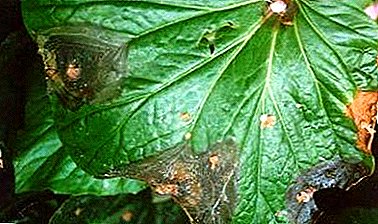 Mealy Dew. Dew is associated with fungal diseases. Initially appears in the form of light spots on the leaves. Inaction leads to rapid spread, a special love for the yellow inflorescences. Treat begonia can be a systemic fungicide in the form of a spray. To prevent infection, use the drug before blooming buds.
Mealy Dew. Dew is associated with fungal diseases. Initially appears in the form of light spots on the leaves. Inaction leads to rapid spread, a special love for the yellow inflorescences. Treat begonia can be a systemic fungicide in the form of a spray. To prevent infection, use the drug before blooming buds.- Weevil. The most harmful invader begonias. The beetle leaves eggs in the soil. The newly emerged larvae sink into the tuber, eat it, causing infallible damage. There is a whole list of pest control agents. The best insect extermination - Provado.
Breeding features
Begonia can be propagated in several ways:
- Cuttings. On a cut-off handle, a pair of whole leaves should remain. Spread the slices with powdered activated carbon. Each stalk is planted in a personal container. A plant is taken for about a month at a temperature of 20 ° C and good soil and air moisture. Avoid open sun, place saplings priten.
- The division of the bush. The bush is divided at the same time with the root part, planted in personal pots. At the time of rooting the flower should be in a warm room.
Begonia Mix will be a wonderful gift for every connoisseur of the delightful world of plants. It is only necessary to provide her with constant care and to fulfill the easy requirements, and she will surely respond, delighting you with her variegated colors.


 Top dressing. Top dressing is applied twice a month, starting from the period of bud formation and during the entire flowering period. It affects decorative-flowering representatives. For foliage species, nitrogen-free mixtures are required, because this micronutrient accelerates foliage development, slowing the flowering process.
Top dressing. Top dressing is applied twice a month, starting from the period of bud formation and during the entire flowering period. It affects decorative-flowering representatives. For foliage species, nitrogen-free mixtures are required, because this micronutrient accelerates foliage development, slowing the flowering process. Mealy Dew. Dew is associated with fungal diseases. Initially appears in the form of light spots on the leaves. Inaction leads to rapid spread, a special love for the yellow inflorescences. Treat begonia can be a systemic fungicide in the form of a spray. To prevent infection, use the drug before blooming buds.
Mealy Dew. Dew is associated with fungal diseases. Initially appears in the form of light spots on the leaves. Inaction leads to rapid spread, a special love for the yellow inflorescences. Treat begonia can be a systemic fungicide in the form of a spray. To prevent infection, use the drug before blooming buds.